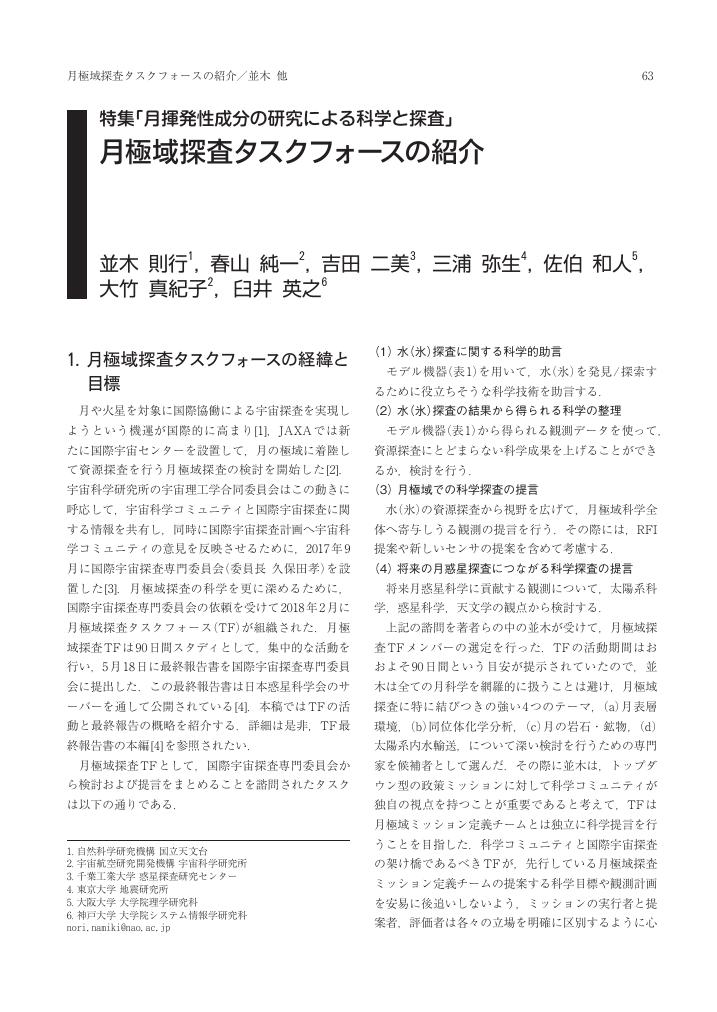4 0 0 0 OA 月極域探査タスクフォースの紹介
- 著者
- 並木 則行 春山 純一 吉田 二美 三浦 弥生 佐伯 和人 大竹 真紀子 臼井 英之
- 出版者
- 日本惑星科学会
- 雑誌
- 日本惑星科学会誌遊星人 (ISSN:0918273X)
- 巻号頁・発行日
- vol.28, no.1, pp.63-67, 2019-03-25 (Released:2019-08-16)
- 著者
- 武谷 賢 並木 則行
- 出版者
- 日本惑星科学会
- 雑誌
- 遊・星・人 : 日本惑星科学会誌 (ISSN:0918273X)
- 巻号頁・発行日
- vol.14, no.3, pp.113-126, 2005-09-25
地球の海洋プレートや金星リソスフェアのテクトニクス, 熱進化において, 冷却するマントルの不安定性の発達は重要な役割を果たしていると考えられる.地球の海洋プレートは70Maまでは単純な半無限媒質の静的な熱拡散モデルで巧く説明できるが, 70Maを越えると地形や熱流量のflatteningが起きる.一方, 金星では300〜700Maに惑星規模のglobal resurfacingが起こったと推測される.われわれは, これらの問題を考えるために, 非圧縮粘性流体の熱拡散問題にブジネスク近似と温度依存の粘性率を取り入れただけの簡単なモデルを構築する.また, 熱境界層の不安定性に固有な新たな時間定数を導入し, 従来の研究成果との比較を行う.そしてこのモデルに線型安定性理論と境界層理論を適用して, secondary convectionが果たす役割について考察を行う.その結果, 地球の海洋プレートではsecondary convectionの熱輸送によって, 50Ma付近でプレートが熱的に定常状態に近づきflatteningがおこることが明らかになった.一方, 金星ではマントルの粘性が高いため, secondary convectionの波長も500〜1000kmと長くなる.この波長は大型火山やコロナ, ridge beltのサイズと調和的であるが, secondary convectionがglobal resurfacingの引き金になるとは考えにくい.
- 著者
- 岩田 隆浩 南野 浩之 佐々木 健 小川 美奈 並木 則行 花田 英夫 野田 寛大 松本 晃治 今村 剛 石原 吉明 鶴田 誠逸 浅利 一善 劉 慶会 菊池 冬彦 Goossens Sander 石川 利昭 河野 宣之 高野 忠
- 出版者
- The Geodetic Society of Japan
- 雑誌
- 測地学会誌 (ISSN:00380830)
- 巻号頁・発行日
- vol.55, no.2, pp.135-150, 2009-07-25
- 被引用文献数
- 10
SELENE Main Orbiter (KAGUYA) has separated two small sub-satellites; (1) the Relay Satellite "OKINA (Rstar)", and (2) the VLBI Radio Satellite "OUNA (Vstar)". These sub-satellites started to perform 4-way Doppler measurements using Relay Satellite Transponder (RSAT) and multi-frequency phase-delay differential VLBI using VLBI Radio Sources (VRAD) for lunar gravity mapping. We have developed the frequency conversion system, multi frequency S/X-band vertical dipole antenna, and light weighted S-band patch antenna to perform these missions. Simple structured release mechanism has also been developed and confirmed its performance by ground test and orbital demonstration using micro-Lab Sat.<BR> Initial check out were executed and properties of satellite bus equipments, onboard mission instruments, and observation systems including ground stations were evaluated. Electric power and thermal control subsystems have shown that they conduct as designed and inspected in the ground tests. The release mechanisms have given the spin which can maintain the stability of the satellite attitudes. Communication functions of mission instruments conform to the link budgets. These results suggest that OKINA and OUNA have enough performances to produce efficient data by RSAT/VRAD gravity observations.
- 著者
- 岩田 隆浩 南野 浩之 佐々木 健 小川 美奈 並木 則行 花田 英夫 野田 寛大 松本 晃治 今村 剛 石原 吉明 鶴田 誠逸 浅利 一善 劉 慶会 菊池 冬彦 Goossens Sander 石川 利昭 河野 宣之 高野 忠
- 出版者
- 日本測地学会
- 雑誌
- 測地学会誌 (ISSN:00380830)
- 巻号頁・発行日
- vol.55, no.2, pp.135-150, 2009 (Released:2012-03-28)
- 参考文献数
- 16
SELENE Main Orbiter (KAGUYA) has separated two small sub-satellites; (1) the Relay Satellite “OKINA (Rstar)”, and (2) the VLBI Radio Satellite “OUNA (Vstar)”. These sub-satellites started to perform 4-way Doppler measurements using Relay Satellite Transponder (RSAT) and multi-frequency phase-delay differential VLBI using VLBI Radio Sources (VRAD) for lunar gravity mapping. We have developed the frequency conversion system, multi frequency S/X-band vertical dipole antenna, and light weighted S-band patch antenna to perform these missions. Simple structured release mechanism has also been developed and confirmed its performance by ground test and orbital demonstration using micro-Lab Sat. Initial check out were executed and properties of satellite bus equipments, onboard mission instruments, and observation systems including ground stations were evaluated. Electric power and thermal control subsystems have shown that they conduct as designed and inspected in the ground tests. The release mechanisms have given the spin which can maintain the stability of the satellite attitudes. Communication functions of mission instruments conform to the link budgets. These results suggest that OKINA and OUNA have enough performances to produce efficient data by RSAT/VRAD gravity observations.
1 0 0 0 OA 『月惑星探査の来たる10年』検討・第一段階報告
- 著者
- 大谷 栄治 倉本 圭 今村 剛 寺田 直樹 渡部 重十 荒川 政彦 伊藤 孝士 圦本 尚義 渡部 潤一 木村 淳 高橋 幸弘 中島 健介 中本 泰史 三好 由純 小林 憲正 山岸 明彦 並木 則行 小林 直樹 出村 裕英 大槻 圭史
- 出版者
- 日本惑星科学会
- 雑誌
- 遊・星・人 : 日本惑星科学会誌 (ISSN:0918273X)
- 巻号頁・発行日
- vol.20, no.4, pp.349-365, 2011-12-25
- 被引用文献数
- 1
「月惑星探査の来たる10年」検討では第一段階で5つのパネルの各分野に於ける第一級の科学について議論した.そのとりまとめを報告する.地球型惑星固体探査パネルでは,月惑星内部構造の解明,年代学・物質科学の展開による月惑星進化の解明,固体部分と結合した表層環境の変動性の解明,が挙げられた.地球型惑星大気・磁気圏探査パネルは複数学会に跨がる学際性を考慮して,提案内容に学会間で齟齬が生じないように現在も摺り合わせを進めている.本稿では主たる対象天体を火星にしぼって第一級の科学を論じる.小天体パネルでは始原的・より未分化な天体への段階的な探査と,発見段階から理解段階へ進むための同一小天体の再探査が提案された.木星型惑星・氷衛星・系外惑星パネルは広範な科学テーマの中から,木星の大気と磁気圏探査,氷衛星でのハビタブル環境の探査,系外惑星でも生命存在可能環境と生命兆候の発見について具体的な議論を行った.アストロバイオロジーパネルでは現実的な近未来の目標として火星生命探査を,長期的な目標として氷衛星・小天体生命探査を目指した観測装置開発が検討された.これらのまとめを元に「月惑星探査の来たる10年」検討は2011年7月より第二段階に移行し,ミッション提案・観測機器提案の応募を受け付けた.
- 著者
- 花田 英夫 岩田 隆浩 菊池 冬彦 劉 慶会 松本 晃治 浅利 一善 石川 利昭 石原 吉明 野田 寛大 鶴田 誠逸 Petrova Natalia Goossens Sander 原田 雄司 佐々木 晶 並木 則行 河野 裕介 岩館 健三郎 亀谷 收 寺家 孝明 柴田 克典 田村 良明 矢作 行弘 増井 亘 田中 孝治 前島 弘則 洪 暁瑜 平 勁松 艾力 玉〓甫 Ellingsen Simon Schlüter Wolfgang
- 出版者
- The Geodetic Society of Japan
- 雑誌
- 測地学会誌 (ISSN:00380830)
- 巻号頁・発行日
- vol.55, no.2, pp.203-221, 2009-07-25
- 被引用文献数
- 5
The Japanese lunar explorer SELENE (KAGUYA), which has been launched on Sep. 14th, 2007, utilizes VLBI observations in lunar gravimetry investigations. This can particularly improve the accuracy of the low degree gravitational harmonics. Combination of ground based VLBI observations and Doppler measurements of the spacecrafts enable three dimensional orbit determinations and it can improve the knowledge of the gravity field near the limb. Differential VLBI Radio sources called VRAD experiment involves two on-board sub-satellites, Rstar (Okina) and Vstar (Ouna). These will be observed using differential VLBI to measure the trajectories of the satellites with the Japanese network named VERA (VLBI Exploration of Radio Astrometry) and an international VLBI network.<BR>Two new techniques, a multi-frequency VLBI method and the same-beam VLBI method, are used to precisely measure the angular distance between the two sub-satellite radio sources Okina and Ouna. The observations are at three frequencies in S-band, 2212, 2218 and 2287 MHz, and one in X-band, 8456 MHz. We have succeeded in making VLBI observations of Okina/Ouna with VERA and the international network, and have also succeeded in correlating of signals from Okina/Ouna, and obtained phase delays with an accuracy of several pico-seconds in S-band.


